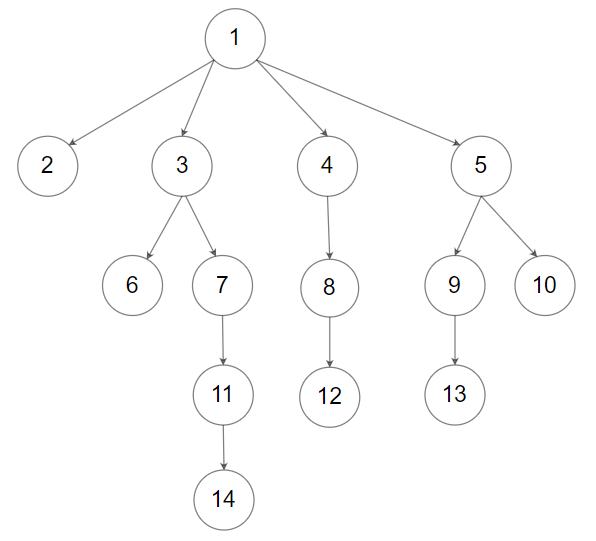【LetMeFly】429.N 叉树的层序遍历:广度优先搜索(BFS)
力扣题目链接:https://leetcode.cn/problems/n-ary-tree-level-order-traversal/
给定一个 N 叉树,返回其节点值的层序遍历。(即从左到右,逐层遍历)。
树的序列化输入是用层序遍历,每组子节点都由 null 值分隔(参见示例)。
示例 1:

输入:root = [1,null,3,2,4,null,5,6] 输出:[[1],[3,2,4],[5,6]]
示例 2:

输入:root = [1,null,2,3,4,5,null,null,6,7,null,8,null,9,10,null,null,11,null,12,null,13,null,null,14] 输出:[[1],[2,3,4,5],[6,7,8,9,10],[11,12,13],[14]]
提示:
- 树的高度不会超过
1000 - 树的节点总数在
[0, 10^4]之间
方法一:广度优先搜索(BFS)
和之前二叉树的广度优先搜索一样,我们可以使用一个队列来存放每一层的节点,再让这些节点依次出队,并将节点的孩子们(如有)入队。
- 时间复杂度 O ( N ) O(N) O(N),其中 N N N是节点个数
- 空间复杂度 O ( N 2 ) O(N2) O(N2),其中 N 2 N2 N2是节点最多的一层的节点数
AC代码
C++
class Solution {
public:vector<vector<int>> levelOrder(Node* root) {vector<vector<int>> ans;queue<Node*> q;if (root) {q.push(root);}while (q.size()) {ans.push_back({});for (int _ = q.size(); _ > 0; _--) {Node* thisNode = q.front();q.pop();ans.back().push_back(thisNode->val);for (Node* nextNode : thisNode->children) {q.push(nextNode);}}}return ans;}
};
Python
# from typing import List, Optional# Definition for a Node.
class Node:def __init__(self, val=None, children=None):self.val = valself.children = childrenclass Solution:def levelOrder(self, root: Optional[Node]) -> List[List[int]]:ans = []q = []if root:q.append(root)while q:ans.append([])for _ in range(len(q)):thisNode = q[0]q = q[1:]ans[-1].append(thisNode.val)for nextNode in thisNode.children:q.append(nextNode)return ans针对于Python的语法糖,若使用两个数组可以很大程度上减少代码量(甚至提高效率):
# from typing import Optional, List# Definition for a Node.
class Node:def __init__(self, val=None, children=None):self.val = valself.children = childrenclass Solution:def levelOrder(self, root: Optional[Node]) -> List[List[int]]:ans = []a = []if root:a.append(root)while a:ans.append([thisNode.val for thisNode in a])a = [nextChild for thisNode in a for nextChild in thisNode.children]return ans
同步发文于CSDN,原创不易,转载经作者同意后请附上原文链接哦~
Tisfy:https://letmefly.blog.csdn.net/article/details/136136336






 —— 前端要学的测试课 从Jest入门到TDD BDD双实战(六))


:pip安装及如何加速安装第三方组件)

![【web | CTF】BUUCTF [网鼎杯 2020 青龙组]AreUSerialz](http://pic.xiahunao.cn/【web | CTF】BUUCTF [网鼎杯 2020 青龙组]AreUSerialz)







